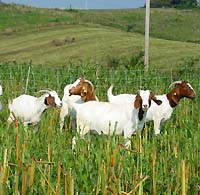Byproduct Feeds Provide Economical Option for Goats
Byproduct Feeds Provide Economical Option for Goats


Meat goats provide farmers additional income opportunities and allow them to further diversify their operations. Tobacco farmers in particular have found goats important in transitioning into other agricultural enterprises.
“One such emerging opportunity is the slaughter goat feed lot operation,” said Terry Hutchens, University of Kentucky College of Agriculture Extension associate for goat management. “This is where lightweight, 30- to 40-pound goats are purchased and fed out to slaughter weight.”
Hutchens pointed out that grain-based feeds may not be economical for growing and finishing goats to 65 and 75 pounds. Additionally, commercial, high-starch feeds may lead to reduced ruminal pH which can cause metabolic problems and reduced fiber digestion. These things add up to overall feed inefficiency. Hutchens said recent research by UK showed some by-product feeds containing highly digestible fiber can provide adequate gain without the management problems associated with high-starch or high-grain diets.
The research compared two Kentucky byproduct feeds containing 20 percent and 30 percent distillers dried grain, Kentucky-grown soybeans, whole corn and a commercial pelleted feed. The feeds were fed to 60 slaughter goats with a start weight of 40 pounds.
“All the goats gained an average of 35 pounds in 56 days,” Hutchens said. “The overall rate of gain was a half-pound per day. There was no difference in total gain or rate of gain for the three treatments, but the cost of the commercial feed was twice that of the by-product alternative.”
Hutchens said the study shows that byproduct feeds are good alternatives to high-starch grain products.
“There were fewer metabolic problems associated with the byproduct feeds,” he said. “Total weight gain was comparable to the commercial alternatives and there is a definite economic advantage.”
Some disadvantages exist because protein and energy may be variable. Hutchens said farmers need to regularly submit samples for feed analysis. Many byproducts may contain a fine dust, and molasses may need to be added to control it. One other disadvantage is that bulk or bagged course feeds may be less convenient than pelleted commercial feeds.
“The cost and return difference for feeding these byproducts make the disadvantages miniscule in comparison to the cost of commercial feeds,” he said.
